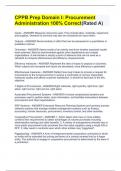Summary
Summary *DISTINCTION ACHIEVED* Family Law Elective Revision Summaries (Ulaw)
- Module
- LPC - Legal Practice Course
- Institution
- LPC - Legal Practice Course
HIGH DISTINCTION ACHIEVED Hi Family Law revision notes covering the following topics: 1. Tax on marriage breakdown 2. ADR 3. Legal Help and Funding 4.The Statutory Charge 5. Divorce 6. Pre-marital agreements 7. Financial orders 8.Enforcement, appeals and setting aside orders 9. Dealin...
[Show more]





